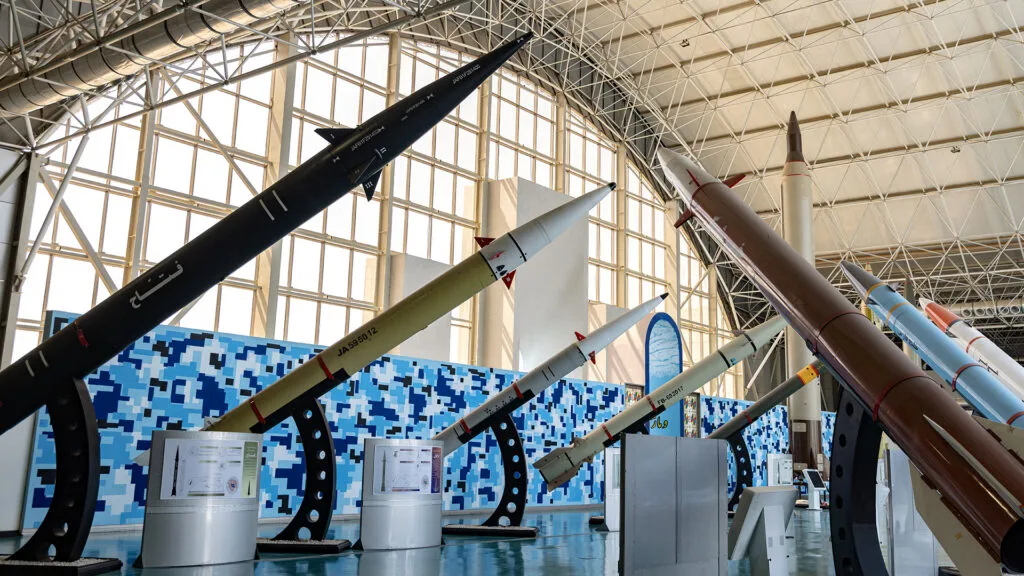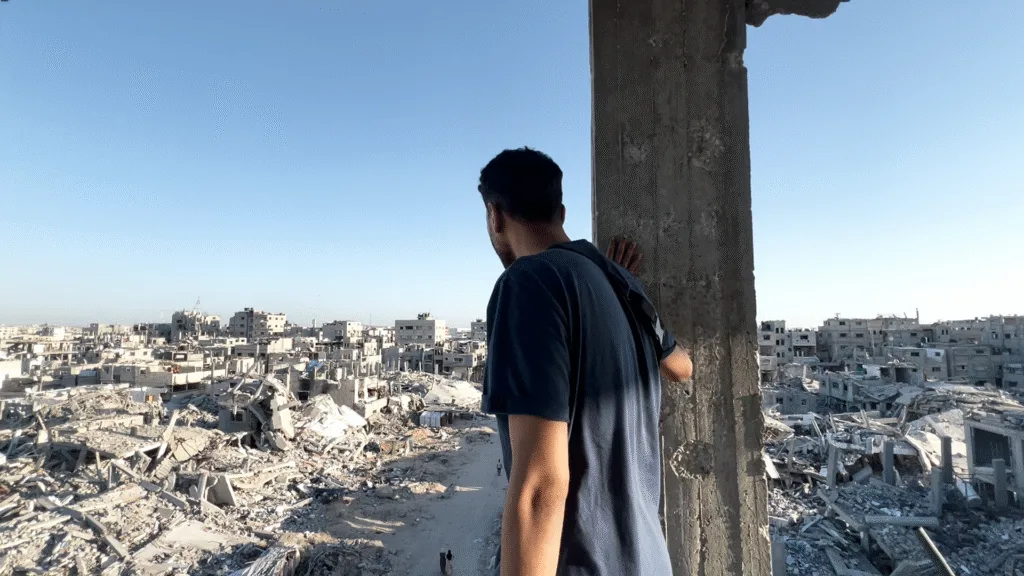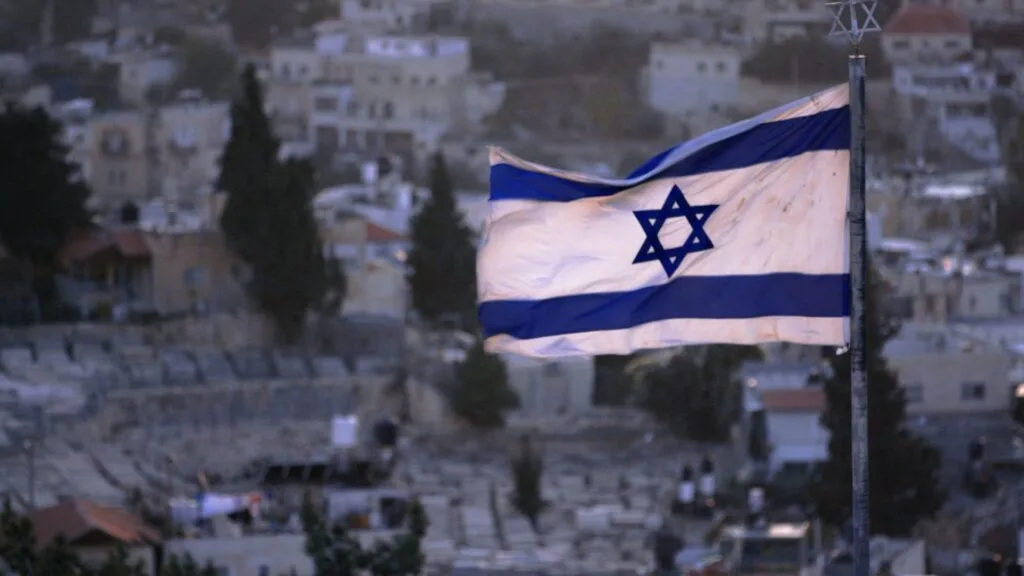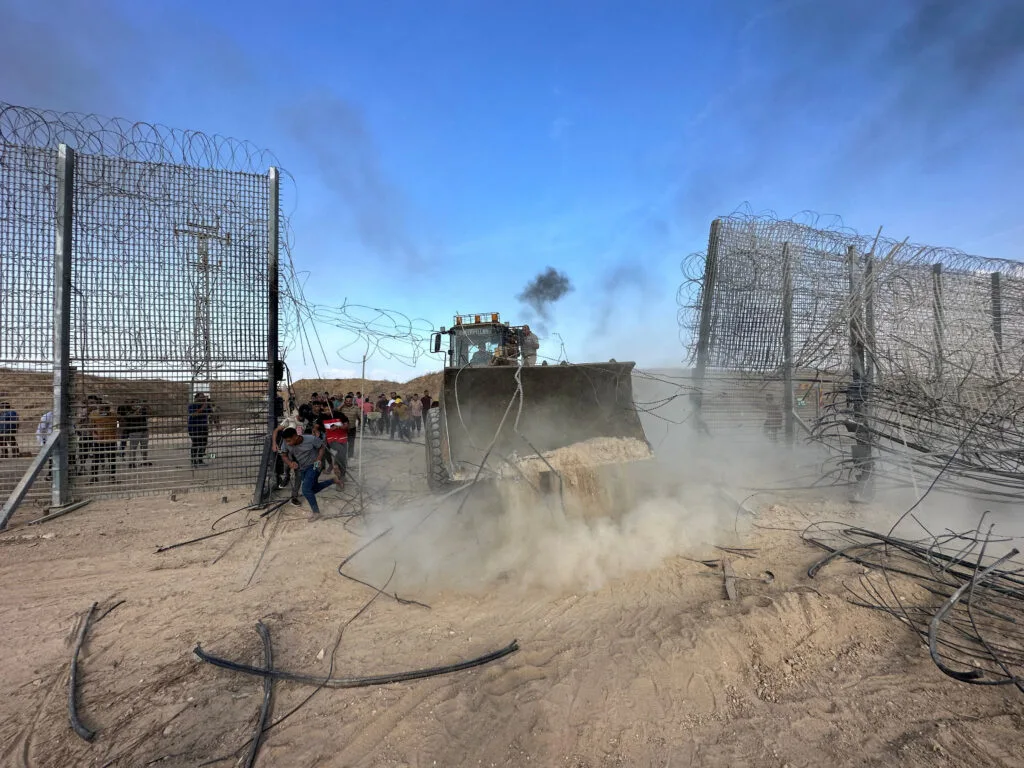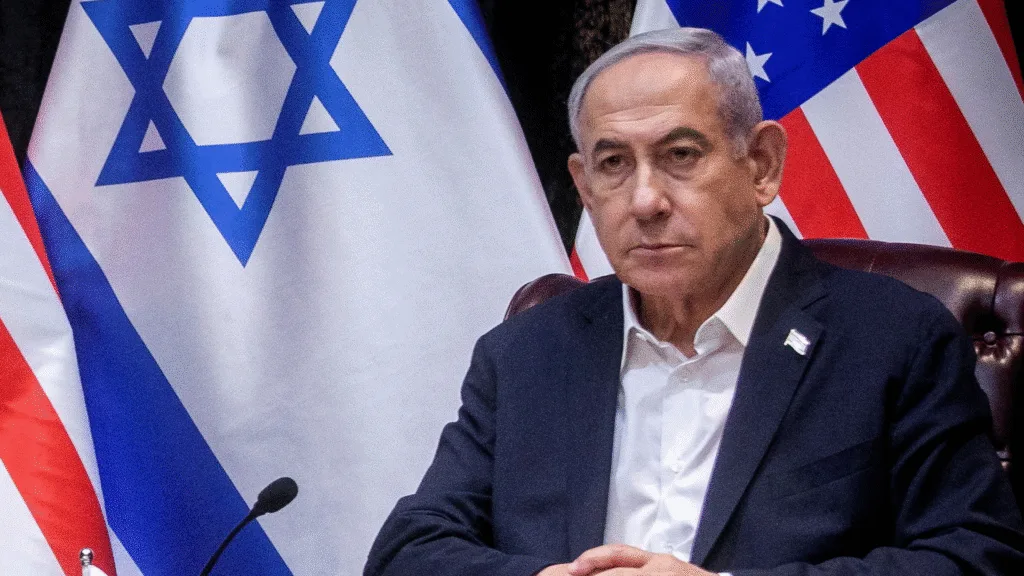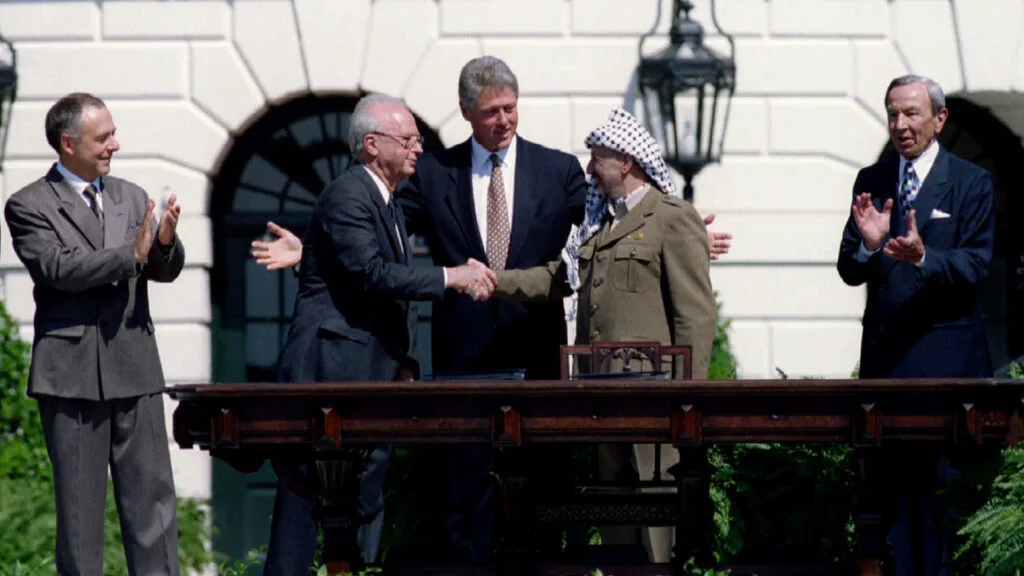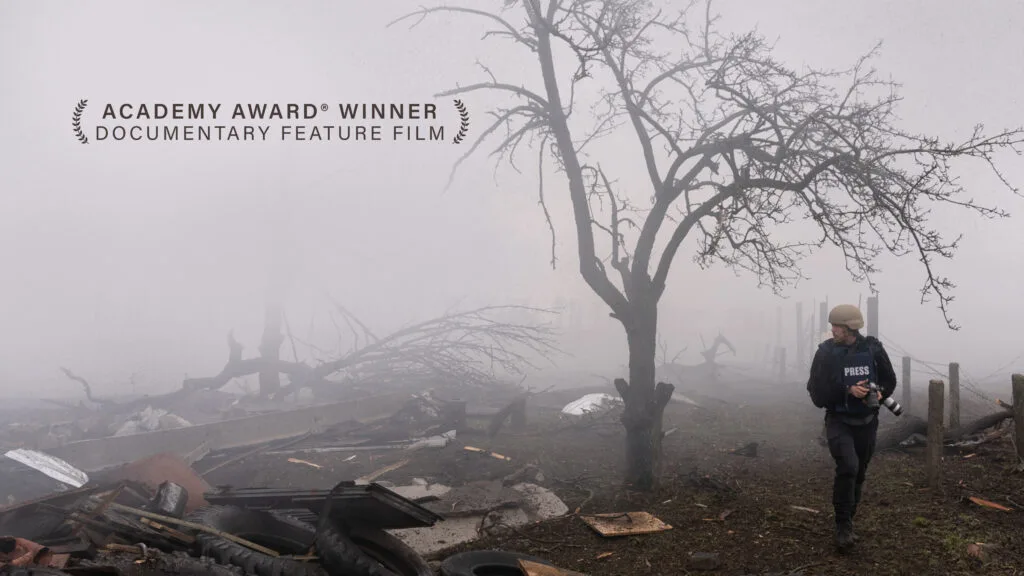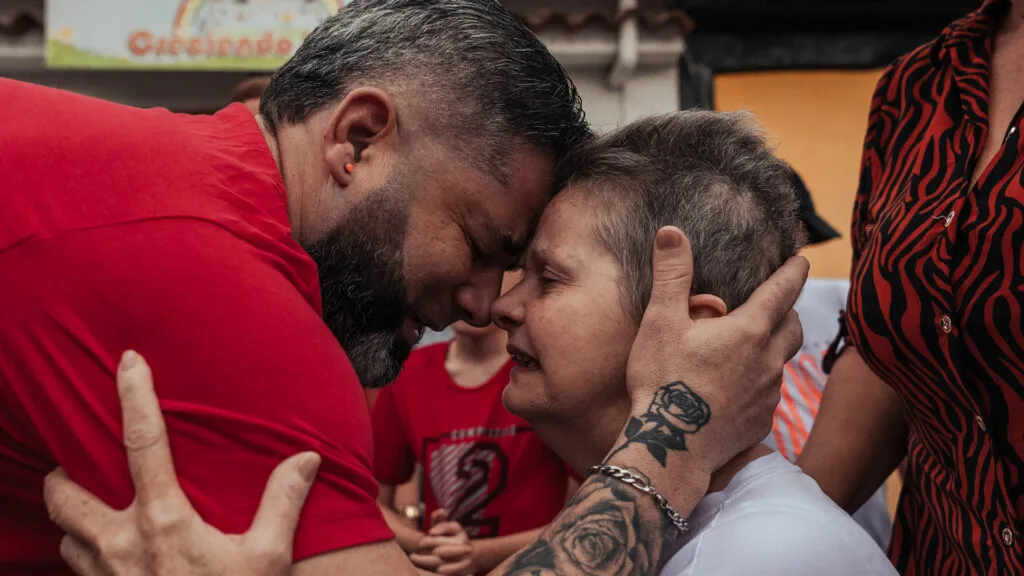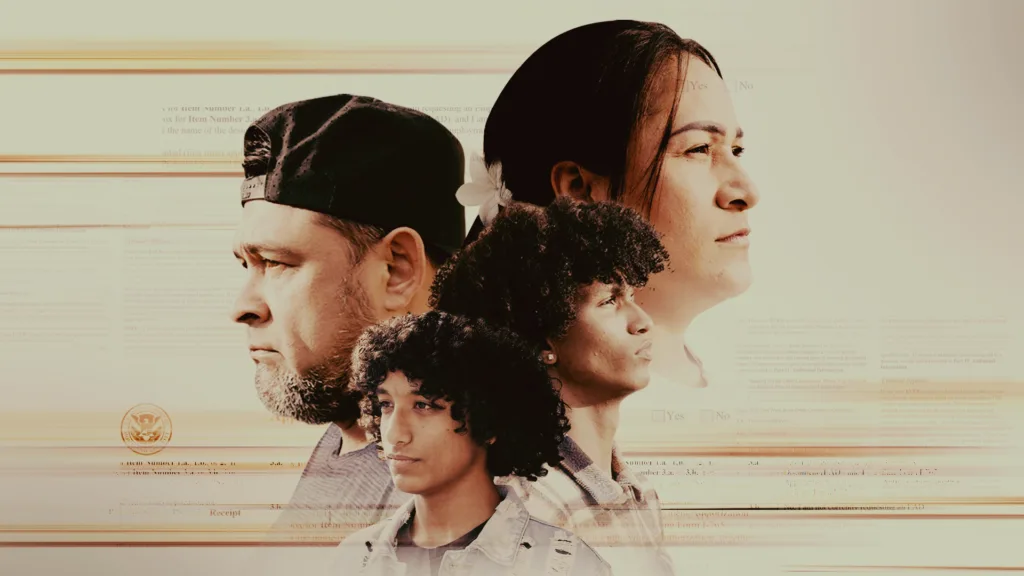Brett McGurk
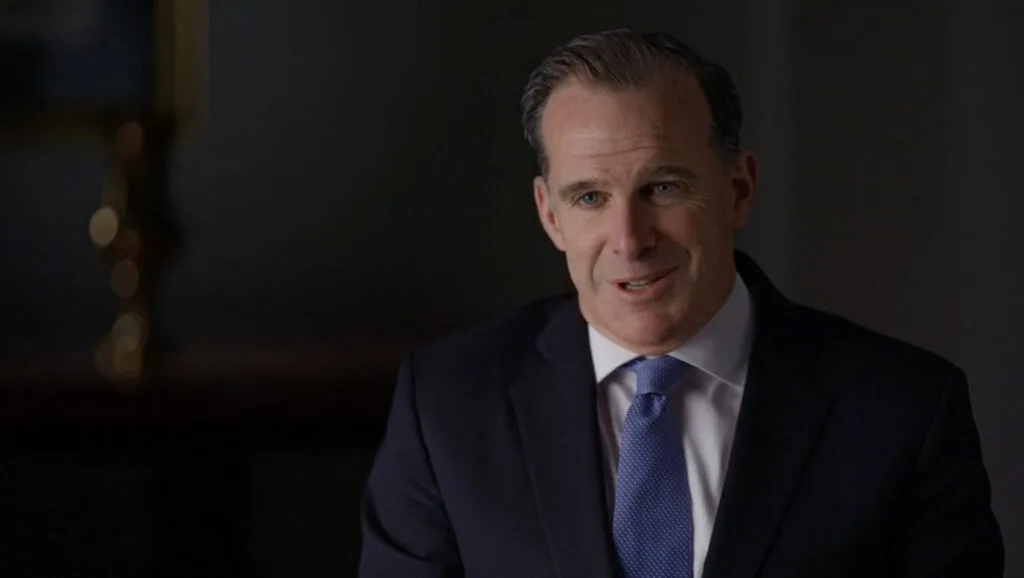
December 19, 2023
Share
Brett McGurk is currently the White House coordinator for the Middle East and North Africa, serving under President Biden. In the wake of the Oct. 7 attacks in Israel, McGurk traveled to the Middle East to negotiate the release of Israeli hostages and the flow of aid to Palestinian civilians.
Previously, McGurk held senior national security positions in the Obama and Trump administrations and served as special presidential envoy for the Global Coalition to Defeat ISIS from 2015 to 2018.
The following interview was conducted by FRONTLINE journalist James Jacoby on Dec. 8, 2023. It has been edited for clarity and length.
Read more interviews from Netanyahu, America & the Road to War in Gaza.
I’m curious how you reflect in retrospect, given the current moment and the current conflict, on the decision to go ahead with the Saudi deal, to expand upon the Abraham Accords, and how that looks to you in retrospect.
Well, I think it’s important to keep in mind, first of all, we don’t have a deal, so it’s hard to judge what is in that package until there actually is a deal. And I think one of the mischaracterizations has been that the discussions with Saudi Arabia and Israel somehow was making an end run around the Palestinian issue. In fact, it’s quite the opposite.
We took an approach to this deal, really partly because it was central to our policy, our entire approach, and also central to the Saudi readiness to move forward, that the Palestinians did not only have a central piece of that potential arrangement, but they were effectively partners in the arrangement. So the Palestinian leadership kind of changed its position as we began this process, that not only would it not sit on the sidelines, but they would actually be a part of this, and that if there were to be normalization between Saudi Arabia and Israel, which is just a tremendous game changer, that there has to be a significant, meaningful Palestinian component of that ultimate package.
I’ll just make some points about how you saw this play out. For the first time really since 1967, you saw Saudi officials in Ramallah, in the West Bank, engaging directly with the Palestinian leadership there. You saw the Palestinians in Saudi Arabia—and I was there for those talks—engaging in that process. So I would just say, the premise to your question, I would reserve judgment on what that ultimate deal looks like, because the Palestinian piece of it is central to the whole thing holding together.
In fact, as President [Joe] Biden has since said, when he sat down with Prime Minister [Benjamin] Netanyahu in New York at the U.N. General Assembly just at the end of September, a couple of weeks before the horrific attacks by Hamas on Oct. 7, the main topic of that meeting, which lasted almost two hours, was about the Palestinians and how they fit into the Saudi deal. I think that’s important context.
Now, I’ll say Gaza was not a part of that process, and that’s because Hamas is in charge of Gaza. So as we look forward, there is potential here to actually incorporate Gaza into this and actually have a reunified Palestinian governance structure between Gaza and the West Bank. But obviously, this has some time to play out. But just the premise of your question, looking back, it’s important to keep in mind you can’t really judge what that package looked like, because first of all, it’s not completed. Nobody’s seen it. I happen to know what’s in it. But the Palestinian component of that package is transformational, meaningful, and without it, there would not be a deal. So we’ll have to see where this goes from there. But I think that’s an important context of that history.
Are you able to give any more detail on what the Palestinian aspect of that deal would be?
I’m not going to—you know, one thing I do as a negotiator is not talk about the negotiation too much until it’s actually finished, because these are dynamic processes. I would say the discussions between Saudi Arabia and Israel started back during the president’s trip to the Middle East in the summer of 2022, and in a very deep engagement with Prime Minister [Yair] Lapid at the time, and also the Crown Prince Mohammed bin Salman.
So … we’ve been working at this through successive Israeli governments, and we were making some real progress. I would not guarantee it was going to get done, but I will say, as the president has said, it remains very much on the table. And in fact, when you take it into the full account of what that deal encompasses, and particularly how the Palestinians fit in — and how the Palestinians themselves, again, were a part of this process — I think that’s very important. I think there is an important opportunity there.
I’d like to fast-forward to, obviously, after the horrific attacks on Oct. 7.
I’d say one more thing, because maybe it can be useful. But if you’re looking at the history, I can see by the premise of your question where you might be going. Keep in mind, when President Biden came into office, relations between the United States and the Palestinian Authority, and the Palestinian people, had almost basically been severed, and we reestablished relations with the Palestinian Authority. We re-funded UNRWA [United Nations Relief and Works Agency for Palestine Refugees in the Near East], which is the only humanitarian distribution network, including in Gaza, and we restored a lot of what had been lost. It takes time to rebuild this back up. But the president went to Ramallah. He went to Ramallah in the summer of 2022, and he stood with President [Mahmoud] Abbas and said, “Our policy is two states, a Palestinian state, based on 1967 lines, with swaps.” Our policy has been very clear. But of course, it takes time to rebuild that foundation, to make that even possible.
I will just say, finally, the Saudi-Israel process had a central component for the Palestinians. But what that package ultimately looks like will be judged once it is ultimately concluded.
Thank you. That’s very helpful context. Was there pushback from Netanyahu in that meeting at the U.N. about the Palestinian component of the deal?
I would just say I think when it comes to Israel-Saudi normalization, the prospect of that game-changing dimension of it and what it brings allows leaders, including Bibi—I’m not going to speak for Bibi—to consider things, particularly when it comes to the Palestinians, that might not otherwise be possible. And so I think in the context, even given the context of Israeli politics and what it is—and I think you have to; we all have to deal in the real world here—the dimension of the potential for Saudi-Israel normalization provided a lever that otherwise I don’t think was there. And I thought that conversation in New York was quite constructive.
I’m not going to divulge what was discussed, but I think it was quite constructive and had and remains some real potential. Again, the focus was on the West Bank, OK? The focus was not on Gaza for reasons I think we understand. Hamas was in charge of Gaza and has been since 2006, which has been a main impediment to any realistic process or prospect of two states. But in that dimension, the discussion of the West Bank, the future there and how that fit into the prospect of Saudi normalization, which remains a prospect—was a prospect then, remains so now—I thought it was a constructive discussion. The president and Bibi know each other well. They know the issues, and I thought it set a pretty good foundation for moving forward.
Again, moving forward to the trip to Israel, you were with the president, and I’m just kind of curious. There’s the famous hug, and there’s obviously an attempt, and a very poignant one, to express solidarity with the Israelis at this time of great tragedy. But I take it there was also this concurrent message of restraint, of “Learn from 9/11”; this is what the president was saying. What, from your perspective, was the message that was meant to be conveyed on that trip to Netanyahu in particular?
You know, President Biden recognized very early on in this horrific crisis—and we were woken up at 2:30 in the morning on Oct. 7, which first looked like rocket attacks. And then as events unfolded and we learned more facts over the course of the next 24-48 hours, this unbelievably horrific attack, the slaughter of over 1,000 people—200 people—families, children, toddlers—being taken hostage, and the regular calls over that first week between the president and Bibi and other Israeli leaders. And I have to say, we came perilously close to a much broader regional conflict in that first week in the fog and the friction and the unknowns.
The president knew he had to get to Israel, and he had to sit with the Israelis face-to-face. And he was right. And I have to say, when you work on a presidential trip, you want to have it all scripted; the deliverables are all ready. This trip was very different.
The president knew he had to fly into what is an active war zone, into great uncertainty, because he had to sit with the Israelis face-to-face, not just Bibi, but with the Israeli leadership. And so he did, and he met the war cabinet.
And remember, the war cabinet formed over the first week of the crisis to provide a kind of unified decision-making collection of very senior people, including Prime Minister Netanyahu and some of his main political rivals. It was a real symbol of unity, the unity the country needed to confront this.
So the president knew he had to go sit face-to-face to talk through where this was going. And at the time, remember, it wasn’t just Prime Minister Netanyahu, but all the Israeli political leadership; their position was no humanitarian assistance should go into Gaza until the hostages come home. That was the unanimous view, and the president wanted to go face-to-face and say, “We cannot accept that. We cannot accept that policy. We have to see humanitarian aid flowing, because ultimately you have to separate Hamas from the population, and we need humanitarian aid to flow, period, period.” And he made that point with Bibi, and he made that point with the war cabinet.
And it was on that visit that they agreed. They met as soon as the president left. They agreed. They changed their policy. The president then had a phone call on Air Force One on the flight home with President [Abdel Fattah El-] Sisi of Egypt to work out a final modality, and the next day trucks began to flow. Is it enough? Have we been working every day since to get even more? Yes, but that visit is what broke that open.
Now the president also, in his deep experience in these issues, as a wartime leader himself and sitting in the Situation Room as vice president and as president and making these decisions, could speak about how difficult it is. The speech he made in Tel Aviv I don’t think has gotten enough focus and attention, but if you look at what he said, and the president worked on the speech on the way to Israel on Air Force One on that overnight flight, speaking from his experience, that “I am the first president to visit Israel in a time of war. I am a president who has made war and peace decisions. These are the most difficult decisions. They require deliberation. They require deep thought. They require consultation. They require setting your objectives carefully and constantly reconsidering whether your policies are reaching those objectives.” I’m not giving you an exact quote, but I recall from the speech we worked on quite a bit on the trip, and that’s about how difficult this is and trying to slow things down, because I have to say, I won’t go into the details now, but the original plan that we had seen left a lot of concern.
That’s what that trip was about, and what he said publicly was very similar to the reflection that was said privately, and he also said, importantly, after meeting the first responders who responded in the kibbutzes and saw this slaughter and the human toll, he said, “Don’t act out of rage,” and talked about our experience in 9/11 and being careful and deliberate and thoughtful. So that’s what that trip was about. I have to say without that trip, the course of events might have unfolded completely differently. That’s about face-to-face diplomacy. That’s what Joe Biden does. It’s what he did in the Senate, as vice president and as president.
I think it might help if you could expound a little bit about how things would have gone differently or could have gone differently. I mean, you’re alluding to the fact that you were presented with plans that were not something that the Americans really wanted to sign onto here. Can you be a little bit more explicit about what the Israelis were planning at that point and how the plans changed as a result of this visit?
I don’t want to get into every detail, and … I think, as you see this play out and as ultimately the military campaign comes to a conclusion—and I have to say this is not our war. It’s not a U.S. war. Israel, a sovereign country making its own decisions, and if you go to Israel, this is a country that is united and mobilized behind this campaign, and you have to consider that. It is not just about the president picking up the phone and calling Bibi. This is a unified [country], and again, the war cabinet includes Bibi’s main political opposition figures, but they are very unified behind this campaign and degrading Hamas’s military capabilities, removing the leaders and ensuring that the threat and Israel can never again be threatened by something like what we saw on Oct. 7. I think that’s important to keep in mind.
Well, one issue here, it had to do with the hostages and how do you—this was early, but how do you structure a military campaign in a way that puts pressure on Hamas, but also leaves potential for a hostage arrangement to get hostages out? And that required a more phased military campaign, a little more deliberate, particularly when it comes to the ground invasion.
… If you fast-forward a little bit, when we got to a hostage deal, because the military campaign had been structured specifically, and if you listen to what the Israelis talk about their war aims, their war aims include, top of the list, is getting the hostages home. So the ground campaign was actually structured in a way to build in the possibility of pauses, even prolonged pauses, to allow hostages to come out. So when we were able to actually reach a hostage deal, you were at the point where the military plan had been designed to actually support a pause.
You can talk to military professionals. This is hard to do. It’s hard if you’re in the middle of an offensive military campaign, particularly in an urban environment, to just stop. That has to be very deliberately done and thoughtfully done. I thought when we eventually got to that point, the Israeli military forces were able to stop and pause and pull back to defensible positions already ready to allow the hostage deal in what ended up being a seven-day pause that would have gone on significantly longer had Hamas agreed to release a number of young women that were part of the deal that it refused to release. But over the seven days, we had no fighting. We had over 100 hostages come out, and that would not have been possible had the Israeli military campaign not been designed for specifically that purpose.
But again, back to the point that you had raised, which was to say that this war, one that could have turned into a regional conflict potentially, and that the Israeli plans could have been different had the president and you not gone over there. Are you able to be a little bit more explicit with me about how things could have gone differently had that trip not been made, had there not been that initial American presence in Tel Aviv?
In the first week of the war, the lack of clear information of exactly what was happening, honestly, in Israel, in Beirut, in Tehran, in Washington … And it’s a classic security dilemma, where one side sees another side moving and believes the worst is coming and might act preemptively to stop it, when in fact the other side might just be moving to more defensible positions, or they’re moving because they’re uncertain. That’s what was happening throughout the Middle East at that moment, including the northern front with Israel and Lebanon.
And there was a thought very early on that this Hamas attack could have been—and our intelligence did not support it, but some on the Israeli side believed this—could have been the first move and kind of a master-plan move in which now Hezbollah is about to enter the war, and were that to happen, Israel was prepared to preemptively act to stop it.
So it took an awful lot of deliberation and consultation and discussion at the highest political levels with the president, with [National Security Advisor] Jake Sullivan and myself and [Deputy National Security Advisor] Jon Finer and [Secretary of State] Tony Blinken and [CIA Director] Bill Burns, speaking with counterparts constantly, sharing information—here’s what we know; what do you see—to kind of clear out that fog and get a better picture. I think the visit, the face-to-face visit and just the president being there, I think it helped slow down time a little bit in that moment of crisis and allowed for some more thoughtful decision-making and forestalled what could have been a multi-front war.
Now I have to say, I’m sitting here on I think day 60 of the crisis, we’re not out of this yet, but if you looked at the moves we’ve made, from moving two carrier strike groups to the region, to repositioning our military forces, to a lot of behind-the-scenes diplomacy, thus far it has been relatively contained to Gaza, but I am not prepared to draw a conclusion. And I have to say, every day throughout this crisis, this has been one of our primary objectives, to try to make sure this conflict is contained to Gaza, but that is hardly a foregone conclusion, and it was especially not a foregone conclusion in that first week to 10 days.
Now, of course there’s a lot of questions about the severity of the civilian casualties in this war. I’m curious if you can bring us into the thinking inside the administration and the response to the idea that, as I know you said, this is an Israeli war. But what is going on behind the scenes in order to, that’s more than just signals and statements to the public, to try to get Israel to try to reduce the amount of civilian casualties in the humanitarian crisis?
I would just say first and foremost, everybody working at this, it’s the human toll, and we see it on all sides of this horrific tragedy. We feel it very much on the Israeli side and the hostages and the families, all of whom we dealt with, and we feel it on the Palestinian side. Thinking as a father of your child under rubble or having been kidnapped, it is horrific. All of us are living with this, and we have these conversations with the Israelis in a very direct way, and we have discussions with them military to military about the best way to proceed.
And we also recognize—and I think it’s important to recognize—that it happens to be true that Hamas has built a subterranean military fortress under schools and hospitals in civilian areas. This is a fact. So you can say, “Well, sorry, Israel, there’s nothing you can do because of that fact,” or you can try to limit and narrow and focus as best you can. And we are trying to limit and narrow and focus as best we can.
The president just spoke with Prime Minister Netanyahu yesterday. I have a pretty good sense of where things are going. But listen, we all want this war to end yesterday. If someone says, “Do you want the war to continue or stop?,” the answer is, of course, stop, but recognizing that if Hamas is fully intact, it simply creates the conditions for the next conflict.
I think ultimately, again, this will be judged by the way it concludes. But we are all very mindful of this. The president is in every conversation. You’ve seen Secretary [of Defense Lloyd] Austin, the vice president, was just in the region speaking to this, Tony Blinken just yesterday. And the military–to-military conversations are—this is really a main focus of exactly how to go about something like this—what do you do when there’s a tunnel complex with Hamas leaders and perhaps hostages underneath a civilian city? This is a very difficult proposition. You do not just go bomb it. That is not our position. And some of the early tactics, frankly, [we] do not agree with at all. And you haven’t seen that from some of the early weeks of the campaign. But I don’t want to sit here and—this is an incredibly difficult dilemma. It’s something we are confronting really even at this hour.
To those who say that the United States should have the leverage in this relationship with Israel to be able to ensure that they are taking greater care when it comes to civilian casualties, what do you say to those people that would say use the leverage to ensure it? Why are we still seeing what some describe as a collective punishment here?
Again, I want to, as this crisis concludes, we’re working very hard to bring it to a point of conclusion to which something better and more durable can be established, including ultimately a Palestinian state, and we’ve said that very clearly. But I think, again, I’m not going to divulge what every single discussion, phone call is like, or what could have been course A, B and C versus what is now course D, which looks very different. But, you know, I accept the premise of your question, but I’m just not going to get into all the details.
… I’m curious about what you’re able to tell us about the sort of pressure that may be exerted by this administration on Netanyahu and the Israelis to try to bring this to a quick conclusion and or reduce the amount of civilian casualties.
I want to say number one, it’s important to keep in mind, the United States of America is the largest, by far, contributor of humanitarian assistance. We are the largest funder of UNRWA, which is the only implementer of humanitarian assistance in Gaza. We probably spend half our time focused on ensuring that as much humanitarian assistance is getting into Gaza as possible. And without the United States of America, there would be none. We are also the only country that is able to have these types of discussions with the Israelis.
I have to say that the scope, particularly of the current ground campaign, the way we understood it, was going to be quite more narrowly focused than otherwise. As Secretary Blinken said yesterday, ultimately the judgment comes from results. And when I was in Israel about two weeks ago, in two hours with the prime minister, most of the conversation was about fuel and getting to the hostage deal, which was difficult, which would result in a cease-fire, in a pause, humanitarian pause, prolonged humanitarian pause. We were very focused on that to get to that point where we had a prolonged pause. But humanitarian pauses is something central to our policy. We support a U.N. Security Council resolution that incorporated the principle of humanitarian pauses. We did not vote for it because it failed to even mention Hamas and condemn Hamas, but we abstained to allow the resolution to go forward, something that we work on every single day.
I would also say, part of the problem here is Hamas and their tactics, and I think there does have to be a focus on that. That does not in any way, in any way, diminish the responsibility of Israel to do all it possibly can to separate the civilian population from militants. So in the north, we insisted on and called for humanitarian corridors and humanitarian pauses to allow the population to move, and most of the population from the north did move. In the south, the Israelis had a concept for a safe zone that the U.N. and others could not possibly support, and we made very clear that’s not going to work; you need something much broader. We’re very hopeful that as operations conclude in the north, people will be able to return north, so [that’s] something that we’re focused on really every single day.
In terms of the hostage negotiations, you mentioned that you were over in Israel, and I’m curious, could you just sort of describe what that was like, especially when it came to Netanyahu in terms of getting him to agree, getting all sides to agree to this humanitarian pause and … also how instrumental a role the president was playing in that?
President Biden, from the earliest days of the crisis, has been hands-on and focused on the hostages and how to get them out. And early on, when we got a call from the Qatari prime minister saying to us he thought he might have an opportunity to begin a process that would lead to hostage releases and thought the United States would have a central role, of course we said, “Let’s try it.” We set up a cell to begin that process, and we did a pilot with two Americans, a mother and a daughter, Judith and Natalie [Ranaan], and worked on that for about two weeks on how, first of all, they’d be located, they would be accessed by the ICRC [International Committee of the Red Cross], they’d be handed over to the ICRC and then brought safely out of Gaza, how that would go, how it would be implemented.
That required a pause, about a six-hour pause in fighting to allow the convoy to pick up Judith and Natalie, the two American citizens, and bring them out. We didn’t know if that would work, but we worked very hard at it. The president made a number of calls with the Qataris and others. We were engaged on a daily basis, and that—it did work, frankly. We got them out. We got them out safely. As soon as they were out, the president called Natalie’s father and then spoke to Natalie and her mom in the Oval Office. I was there with him for that very incredibly emotional call.
But he has engaged with the families of the hostages. And the president gives as long as it takes to have those conversations, you know, a couple hours, incredibly emotional discussions about grief and unknowing and uncertainty.
And we moved from the pilot project, the pilot with Judith and Natalie, to the much larger deal, which again was a difficult deal. It required prolonged humanitarian pause. It required reciprocal releases of Palestinians by the Israelis, and it required Hamas to acknowledge that it was holding these hostages. And I have to say, Hamas in the beginning would not acknowledge holding hostages. What its position was, before the Israelis went in on the ground, Hamas said, “Let’s have a cease-fire. We will then look for hostages. And as we find them, we’ll release them.”
Obviously, that was not enough. They came back and said, just before the ground offensive in the north, and said, “OK, we’ve located 10. Let’s have a cease-fire”—they didn’t give any names—“and these 10 can be released. And then we’ll try to find more during the cease-fire.” That obviously was not enough. The Israelis launched their ground attack in north Gaza.
And over time, Hamas, I do believe they were coming under increasing pressure, and they provided identities of the 10, and then ultimately provided a list with identifying information for 50, which was really the key moment that allowed this deal to move forward. And it was structured in a way that incentivized Hamas to release all the hostages. So four days for 50. If you want another day of a cease-fire, 10 more, and it can go on from there. And if there are 230 or 240 hostages, you’re talking about a very prolonged cease-fire, during which a lot can happen.
But ultimately we got through the first four days. There was a fifth day, a sixth day and a seventh day. On the seventh day, Hamas refused to release a group of young women that it said at the last minute—first it said it wasn’t holding them. Then it acknowledged they were holding them, but they said, “We consider these women soldiers.” And they’re not soldiers. These are young women, some of whom were taken from the music festival. The deal broke down at that point.
I think we’re pressed for time, and I wanted to ask you, just going forward and the vision you mentioned earlier, that President Biden has been committed to a two-state solution [that had] been announced in 2022 in Ramallah. I’m just curious—there is some disagreement, obviously: The present prime minister of Israel does not see things the same way in terms of how things will work the day after this war ends. And I’m curious: What are the prospects for peace and a two-state solution here, given the current landscape, given the current political leadership in Israel, and given the fact that there’s been this terrible war?
I’m not going to make predictions here. I will say where the president believes, as a lifelong friend of Israel, where we ultimately need to go and how he talks with his Israeli counterparts about ultimately getting to that point is very clear. At the same time, in the middle of a conflict, very much recognize that the immediate focus is the conflict and the crisis and managing this crisis, but the president is engaged with regional leaders on a weekly basis.
Just spoke with King Abdullah [II] of Jordan again yesterday about what this ultimately might look like and where we need to go. I think actually there is an opportunity, and I will say, having just been with the president yesterday, the president is prepared to use the mantle of American leadership to try to move in that direction at the right time, at the right moment, and putting a lot of the pieces in place that have to be in place for something like that to succeed and not fall flat. And that work is being done. It is ongoing. But we are also still in the fog and friction of this horrible crisis and working to bring it to a conclusion to set the conditions for any of that. And that really is our immediate focus.
Related Documentaries
Latest Documentaries
Explore
Policies
Teacher Center
Funding for FRONTLINE is provided through the support of PBS viewers and by the Corporation for Public Broadcasting, with major support from Ford Foundation. Additional funding is provided the Abrams Foundation, Park Foundation, John D. and Catherine T. MacArthur Foundation, Heising-Simons Foundation, and the FRONTLINE Trust, with major support from Jon and Jo Ann Hagler on behalf of the Jon L. Hagler Foundation, and additional support from Koo and Patricia Yuen. FRONTLINE is a registered trademark of WGBH Educational Foundation. Web Site Copyright ©1995-2025 WGBH Educational Foundation. PBS is a 501(c)(3) not-for-profit organization.
